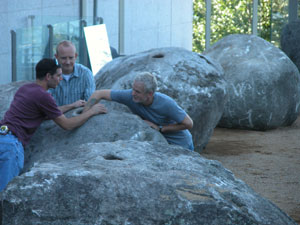About the Garden of Stones at the Museum of Jewish Heritage
British sculptor Andy Goldsworthy’s Garden of Stones, 18 massive stone boulders with holes fire-seared through their centers, was installed in September 2003 at the Museum of Jewish Heritage in New York City. The exhibit came about through the active assistance of a number of people at Cornell. 
The museum’s Memorial Garden is an outdoor space devoted to contemplation and reflection, dedicated to the memory of those who perished in the Holocaust and honoring those who survived. Eighteen boulders were selected because in the Hebrew tradition the number represents life. A single sapling, planted by Holocaust survivors, grows in the hollow within each stone. As the trees mature, each will become a part of the stone, its trunk and roots widening and fusing to the base--the artist’s metaphor for the tenacity and fragility of life.
During a visit to Cornell in December 2002, Goldsworthy and his assistant, Jacob Ehrenberg, met several times with a small group of students, staff and faculty to discuss the planned installation. Graduate students in Cornell’s Department of Landscape Architecture advised on size for the glacial erratic boulders, which were discovered in Vermont fields by Goldsworthy and Ehrenberg. The saplings were grown at Cornell under the guidance of Professor Tom Whitlow from the Department of Horticulture, who recommended the dwarf chestnut oaks (Quercus prinoides) and advised on optimum conditions needed for growth and nourishment of the trees.  The saplings were nurtured at Cornell by faculty and students. Miriam Pinsker ’04, who was then a senior in natural resources, helped transport the saplings to New York City and took part in the planting. The granddaughter of a Holocaust survivor, Miriam went on to earn a MPS (Master of Professional Studies) degree in Cornell Botanic Gardens’ Public Garden Leadership program.
The saplings were nurtured at Cornell by faculty and students. Miriam Pinsker ’04, who was then a senior in natural resources, helped transport the saplings to New York City and took part in the planting. The granddaughter of a Holocaust survivor, Miriam went on to earn a MPS (Master of Professional Studies) degree in Cornell Botanic Gardens’ Public Garden Leadership program.









